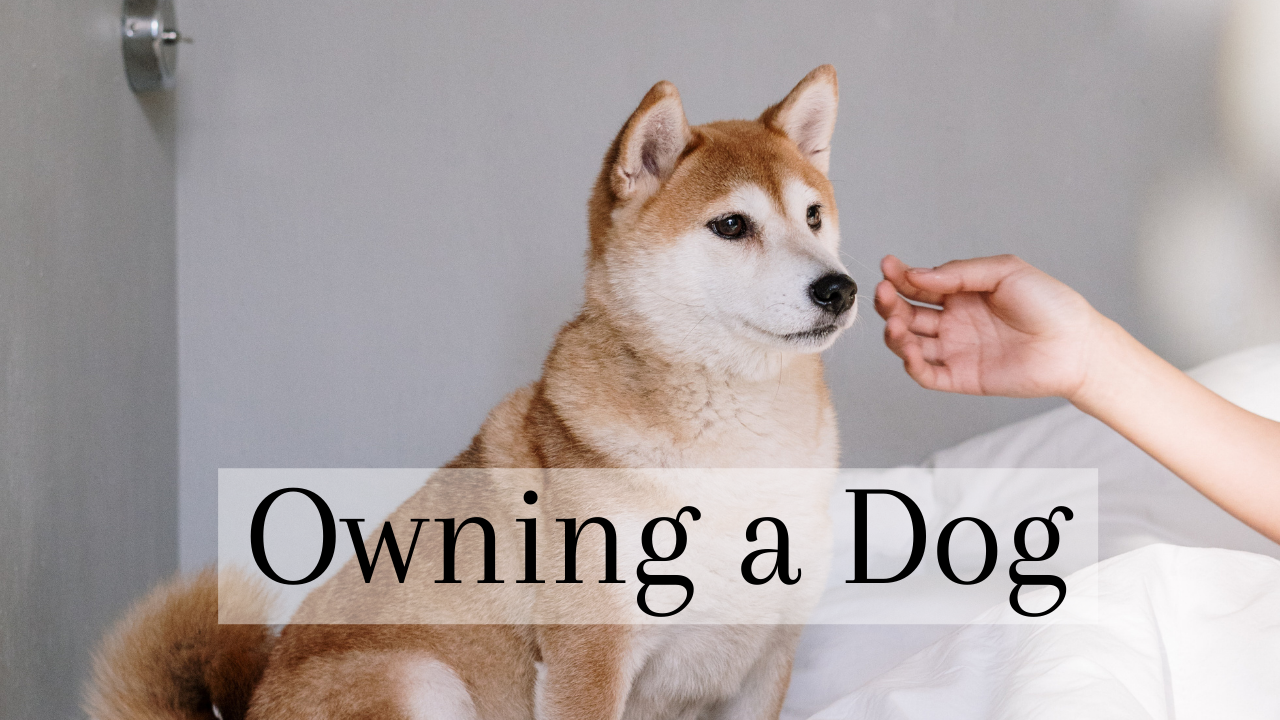Hand Signals Stage 1- Dog Training
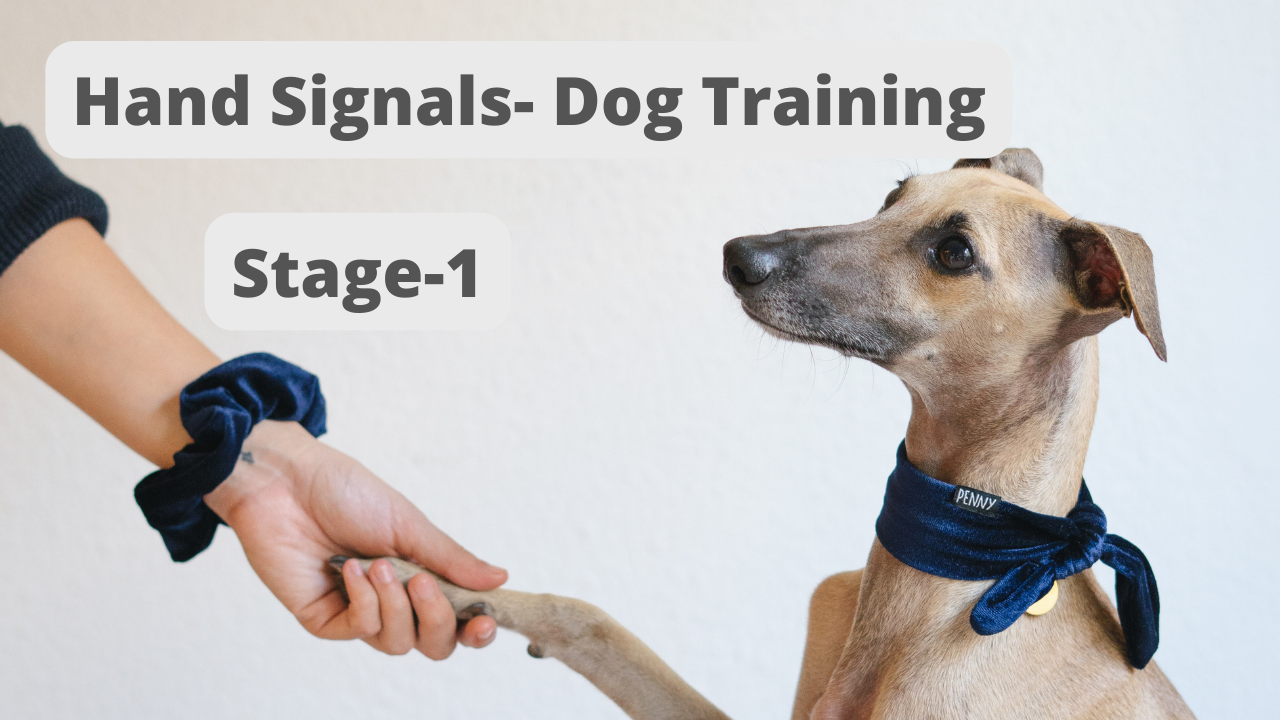
Giving the Treat from the Signal Hand
The first stage of introducing hand signals is the simplest: You hold the treat between the fingers of your
signal hand, and when your dog performs correctly, you give her that treat as her reward. You should go
through all of the routines in this stage in this way before moving on to stage 2.
In addition, use your tone of voice and certain phrases that function as “positive and negative markers”
to convey your level of approval or disapproval and to enhance your communication.
Stand to Sit
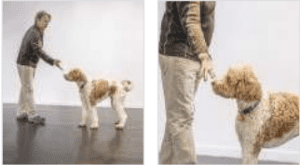
Put the treat between your first two fingers and hold your hand
flat in front of your dog, getting her attention while in stand.

Move your hand up in front
of your dog while keeping her
attention and simultaneously
saying, “Sit.” If you’ve taught
her sit with a treat, she will
move back into sit.
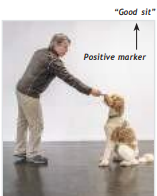
Once she’s in sit, give her the
treat while saying, “Good sit.”
This functions as a “positive
marker” that helps your dog
understand when she’s done
what you’ve asked for.
-
Positive and Negative Markers
Positive and negative markers are auditory aids to help your dog understand when she’s gotten something right or
made a mistake.
For instance, if your dog has properly performed a command, your positive marker might be an enthusiastic
“good.” This is particularly helpful when working with your dog from a distance, since you can’t deliver a more
physical reward quickly (like a pat or a rub). Some people use clickers for this, but in this book, we’re not using clickers, only verbal markers.
On the other hand, a negative marker is a phrase uttered in a sharp tone of voice that helps your dog
understand when she’s made a mistake. The most common is “ah-ah.” This is extremely helpful to your dog,
especially when you’re not near her, to help her understand where the problem is. For more about this, see “On
Using Negative Markers”.
The intelligent combination of positive and negative markers — along with tone of voice — dramatically facilitates learning and profoundly strengthens the communicative and emotional bonds between dogs and their owners.
Sit to Down
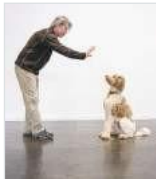
With your dog in sit, use the
treat between your fingers to
get your dog’s attention.
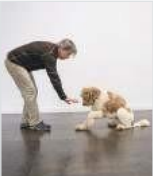
While saying, “Down,” slowly
sweep your hand down in front
of your dog’s nose and all the
way to the ground.

Once your dog is in down, DO
NOT put the treat into your
dog’s mouth.
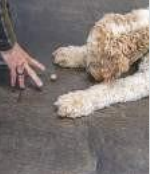 Instead, open your fingers so
Instead, open your fingers so
that the treat drops to the
ground and pull your hand
away. Have your dog pick up
the treat from the ground.
This is VERY IMPORTANT:
You want to teach your dog
to orient to the ground rather than to your hand.
- Note
Eventually, to avoid bending over to deliver
the treat, try the alternate method that
delivers the treat from behind the leg, “Down without Bending Over.
-
The Importance of Tone of Voice
Dogs will never understand human language. However, they can easily learn to recognize words, and they definitely
understand the tone with which words are uttered.
In general, dogs have three tones of voice that they commonly use to communicate with other dogs: high pitched and upbeat, midrange and level, and low and rumbling. These mean pretty much what you’d think. High pitched and upbeat is happy and playful. Midrange and level communicates a range of more level emotions. Low
and rumbling is threatening or angry.
Of course, dog communication involves a full spectrum of much more subtle emotions and meaning, and to
understand what dogs are expressing, we always have to consider multiple factors, including body posture, social
context, and more.
However, for the purposes of training, we can take a page from their communicative repertoire and adapt it to
our interactions to improve the quality of our communications.
In the context of commands and markers, this means that, for a positive marker, you should use an upbeat,
high-pitched tone of voice. For a negative marker, use a low, reprimanding tone of voice. And for general
instructions, use an ordinary but commanding tone that is slightly weightier and more attention-getting than your
ordinary tone of voice
Down to Stand
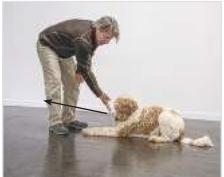
With your dog in a down, use the treat
between your fingers to get her attention.
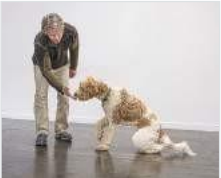
Slowly move the treat away from your dog’s
nose and slightly upward, but parallel with
the floor, while saying, “Stand.”

As your dog stands, say, “Good stand,” as
a positive marker and deliver the treat.
Stand to Down
People commonly overlook practicing down from a stand, since they aren’t sure why they’d ever need the dog
to lie down from a stand. Don’t do that! This exercise leads to a much more advanced and very important
exercise called “Down Out of Motion”, which is used in both heeling and recalls.
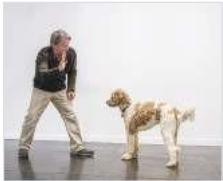
With your dog in stand, hold the treat in
your raised hand slightly above her head.
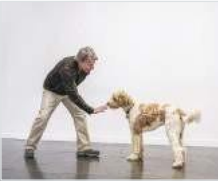
Say, “Down,” and sweep your hand down in
a smooth arc past her nose.
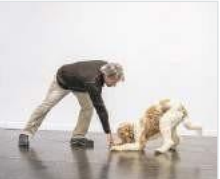
Bring your hand all the way to the ground,
but do not release the treat…
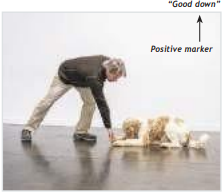
… until your dog is down on all fours. Then
say, “Good down,” …

… and leave the treat on the ground for
your dog. DO NOT let her take it from your
hand.
Down to Sit
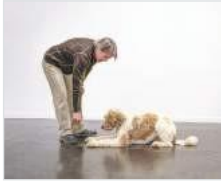
With your dog in down, get your dog’s
attention on the treat.

With your palm facing your dog, and while
maintaining her attention on the treat,
sweep your hand up and above her head
while saying, “Sit.”
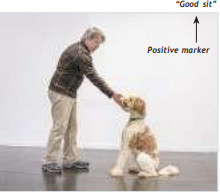
When your dog comes to a sit, say, “Good
sit,” linking the behavior to your positive
marker.



